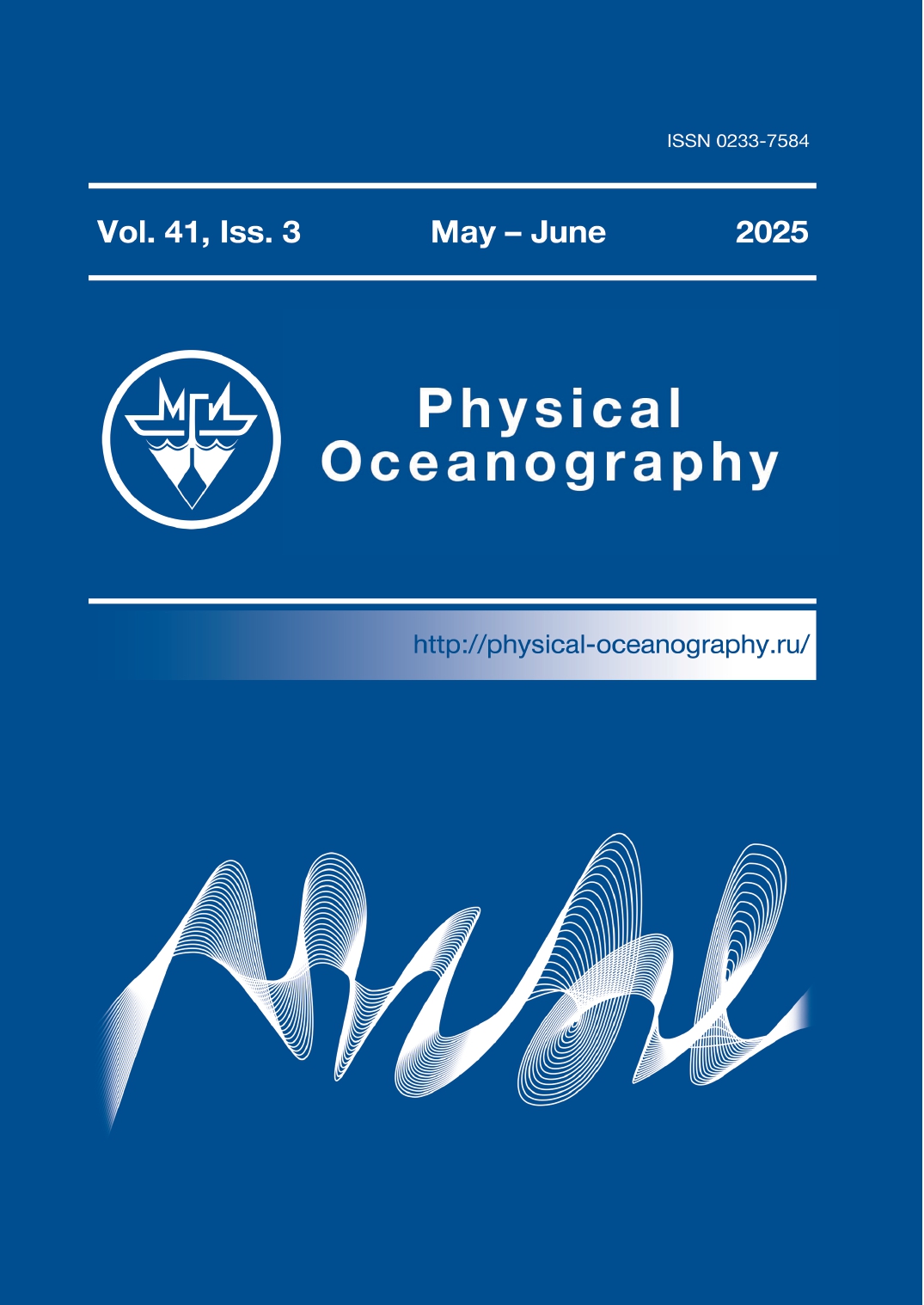Russian State Hydrometeorological University
Russian Federation
Marine Hydrophysical Institute of RAS
Russian Federation
Purpose. Tropical cyclones leave ‘footprints’ on the ocean surface in the form of sea surface height anomalies, which are well observed by satellite altimeters. Recent studies have shown that the values of these anomalies, normalized by the square of the maximum wind speed in the tropical cyclone and the acceleration due to gravity, are a universal function of a dimensionless parameter composed of the radius of maximum wind speed, translation speed of the tropical cyclone and the buoyancy frequency in the seasonal pycnocline. The purpose of this paper is to investigate physical processes responsible for the formation of tropical cyclone wakes in sea surface height anomalies, assess contribution of barotropic and baroclinic modes, and substantiate and quantify the self-similarity of hurricane-induced sea surface height anomalies revealed in satellite altimetry. Methods and Results. The paper considers sea surface height anomalies in wakes of tropical cyclones observed in different regions of the World Ocean from 2010 to 2020. The modelling is carried out using a simplified model of the baroclinic and barotropic response of the ocean to moving tropical cyclones. Calculations show that the first and second baroclinic modes make a significant contribution to the sea surface height anomaly, and the contribution of the third baroclinic mode is of secondary importance. The relative contribution of the barotropic mode depends substantially on the local ocean depth, and it is greater when the ocean is shallower. However, the contribution of the barotropic mode to satellite altimetry measurements of the ocean surface height in wakes of tropical cyclones can be ignored, since the lifetime of the barotropic perturbation is significantly shorter than a typical time interval between the passage of the tropical cyclone and the measurements. Conclusions. Empirical parameterizations of satellite altimetry measurements of the sea surface height anomaly in wakes of tropical cyclones can be reproduced by superposition of the first three baroclinic modes describing the ocean response to the tropical cyclone passage. In this case, the best fit of the modelling results to the measurement data is achieved if the ocean surface drag coefficient at hurricane-force winds has an approximately constant value of 2.25⋅10–3. This result can be considered as an estimate of the momentum exchange between the ocean and the atmosphere at hurricane-force winds, which remains a subject of present-day scientific effort.
tropical cyclone, sea surface height, satellite altimeter, sea surface height anomaly, baroclinic mode, barotropic mode, sea surface height parameterization
1. Geisler, J.E., 1970. Linear Theory of the Response of a Two Layer Ocean to a Moving Hurricane.Geophysical Fluid Dynamics, 1(1-2), pp. 249-272. http://doi.org/10.1080/03091927009365774
2. Ginis, I. and Sutyrin, G., 1995. Hurricane-Generated Depth-Averaged Currents and Sea SurfaceElevation. Journal of Physical Oceanography, 25(6), pp. 1218-1242.https://doi.org/10.1175/1520-0485(1995)025<1218:HGDACA>2.0.CO;2
3. Kudryavtsev, V., Monzikova, A., Combot, C., Chapron, B., Reul, N. and Quilfen, Y., 2019.A Simplified Model for the Baroclinic and Barotropic Ocean Response to Moving Tropical Cy-clones: 1. Satellite Observations. Journal of Geophysical Research: Oceans, 124(5), pp. 3446-3461. http://doi.org/10.1029/2018JC014746
4. Combot, C., Mouche, A., De Boyer Montegut, C. and Chapron, B., 2024. Toward ComprehensiveUnderstanding of Air‐Sea Interactions under Tropical Cyclones: On the Importance of High Res-olution and Multi‐Modal Observations. Geophysical Research Letters, 51(19), e2024GL110637.http://doi.org/10.1029/2024GL110637
5. Zhang, B., Wen, L., Perrie, W. and Kudryavtsev, V., 2024. Sea Surface Height Response to Trop-ical Cyclone from Satellite Altimeter Observations and SAR Estimates. IEEE Transactions onGeoscience and Remote Sensing, 62, pp. 1-9. http://doi.org/10.1109/tgrs.2024.3371168
6. Kudryavtsev, V., Monzikova, A., Combot, C., Chapron, B. and Reul, N., 2019. A SimplifiedModel for the Baroclinic and Barotropic Ocean Response to Moving Tropical Cyclones: 2. Modeland Simulations. Journal of Geophysical Research: Oceans, 124(5), pp. 3462-3485.http://doi.org/10.1029/2018JC014747
7. Orlanski, I. and Polinsky, L.J., 1983. Ocean Response to Mesoscale Atmospheric Forcing. TellusA: Dynamic Meteorology and Oceanography, 35, pp. 296-323.
8. Price, J.F., 1983. Internal Wave Wake of a Moving Storm. Part I. Scales, Energy Budget andObservations. Journal of Physical Oceanography, 13(6), pp. 949-965.http://doi.org/10.1175/1520-0485(1983)013<0949:IWWOAM>2.0.CO;2
9. Khain, A. and Sutyrin, G., 1983. Tropical Cyclones and Their Interaction with the Ocean. Len-ingrad: Gidrometeoizdat, 272 p. (in Russian).
10. Knapp, K.R., Kruk, M.C., Levinson, D.H., Diamond, H.J. and Neumann, C.J., 2010. The Interna-tional Best Track Archive for Climate Stewardship (IBTrACS): Unifying Tropical Cyclone Data.Bulletin of the American Meteorological Society, 91(3), pp. 363-376.http://doi.org/10.1175/2009BAMS2755.1
11. Chavas, D.R., Lin, N. and Emanuel, K.A., 2015. A Model for the Complete Radial Structure ofthe Tropical Cyclone Wind Field. Part I: Comparison with Observed Structure. Journal of the At-mospheric Sciences, 72(9), pp. 3647-3662.
12. Kudryavtsev, V.N. and Pivaev, P.D., 2025. Mixed Layer Depth Parameterization and Ocean Sur-face Cooling Induced by Tropical Cyclones. Ocean Modelling, 195,102514. http://doi.org/10.1016/j.ocemod.2025.102514
13. Edson, J.B., Jampana, V., Weller, R.A., Bigorre, S.P., Plueddemann, A.J., Fairall, C.W., Miller,S.D., Mahrt, L., Vickers, D. [et al.], 2013. On the Exchange of Momentum over the Open Ocean.Journal of Physical Oceanography, 43(8), pp. 1589-1610. http://doi.org/10.1175/JPO-D-12-0173.1
14. Soloviev, A.V., Lukas, R., Donelan, M.A., Haus, B.K. and Ginis, I., 2014. The Air-Sea Interfaceand Surface Stress under Tropical Cyclones. Scientific Reports, 4(1), 5306.http://doi.org/10.1038/srep05306
15. Longuet-Higgins, M.S., 1965. The Response of a Stratified Ocean to Stationary or Moving Wind-Systems. Deep Sea Research and Oceanographic Abstracts, 12(6), pp. 923-973.http://doi.org/10.1016/0011-7471(65)90814-4
16. Donelan, M.A., Haus, B.K., Reul, N., Plant, W.J., Stiassnie, M., Graber, H.C., Brown, O.B. andSaltzman, E.S., 2004. On the Limiting Aerodynamic Roughness of the Ocean in Very StrongWinds. Geophysical Research Letters, 31(18), 19460. http://doi.org/10.1029/2004gl019460
17. Takagaki, N., Komori, S., Suzuki, N., Iwano, K., Kuramoto, T., Shimada, S., Kurose, R. andTakahashi, K., 2012. Strong Correlation between the Drag Coefficient and the Shape of the WindSea Spectrum over a Broad Range of Wind Speeds. Geophysical Research Letters, 39(23), 53988. http://doi.org/10.1029/2012GL053988
18. Ye, L., Li, Y. and Gao, Z., 2022. Surface Layer Drag Coefficient at Different Radius Ranges inTropical Cyclones. Atmosphere, 13(2), 280. http://doi.org/10.3390/atmos13020280
19. Ermakova, O., Rusakov, N., Poplavsky, E., Sergeev, D. and Troitskaya, Y., 2023. Friction Veloc-ity and Aerodynamic Drag Coefficient Retrieval from Sentinel-1 IW Cross-Polarization C-SARImages under Hurricane Conditions. Remote Sensing, 15(8), 1985.http://doi.org/10.3390/rs15081985















